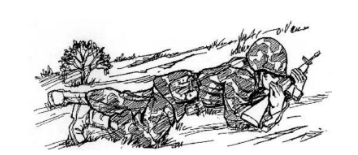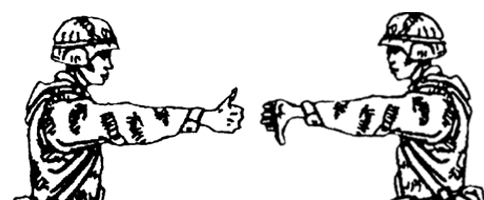- Formidable Function
- Posts
- LP/OP #3
LP/OP #3
The Listening Post/Observation Post
Welcome back to the LP/OP, friend.
This newsletter shares insights from the highly pragmatic military methodologies learned throughout my nearly 20 years spent in the military and private sector.
We do so briefly, clearly, and concisely with respect for your time.
Every week we cover new…
Tactics, Techniques, and Procedures (TTPs)
Inspirational Exemplars
Tactic: Cover and Move

While this tactic has been a military staple for centuries, former Navy Seal Jocko Willink has made this a mainstay of his lifestyle and brand.
This fundamental military tactic is about teamwork where one element covers the advancement of another. Mutual support ensures the team's forward movement is protected and sustained.
This translates to any team or group of people, synchronized to achieve goals together and support each other. Dan Koe advocates for joining “mastermind” groups on platforms like 𝕏 and Threads. These groups deploy the cover and move tactic in this realm by amplifying one another’s voices on social media to build audiences faster and to stoke more engagement.
On a personal level, this can be as simple as family members or friends supporting one another to achieve individual goals, ensuring that every member’s needs are met or at least plans are in place to get there. The key for the cover and move tactic to be effective is to focus on covering for others. It is not “easy” running from position to position, seeking security or success, depending on your aims and environment. Our coverage from our friends, family, and teammates becomes paramount to survive and thrive.
Cover down for your team.
Technique: Silent Communication

In military operations, silent signals are crucial for covert actions and maintaining stealth, using non-verbal cues to convey messages.
This communication may occur using various equipment to include laser technology, flashlights and colored lenses, or prescribed hand and arm signals. However, silent/non-verbal communication is most effective over time when teams have achieved or overcome adversity together. You may have experienced this on a team or with a sibling, when you can intuit what they are thinking and act congruently. This is particularly effective in environments where discretion is necessary, or during critical negotiations where subtle cues can be strategically advantageous.
Silent communication can be useful in all relationships, enhancing understanding through body language, facial expressions, and other non-verbal forms of interaction.
Tune in to your teammates.
Procedure: Strategic Withdrawal

Sometimes, tactical retreats are necessary to preserve forces towards a more favorable future battle.
This involves withdrawing from a current position to regroup and strategize for a stronger comeback. This might manifest as pivoting from a failing strategy or product line to refocus resources on more promising opportunities.
Personally, this could mean stepping back from overwhelming situations to regain composure or reevaluate one’s approach to challenges.
Bottom line, pull yourself out of situations that clearly aren’t working for you.
Avoid burnout.
Inspiration: Major Richard “Dick” Winters
US Army 101st Airborne Division 506th Parachute Infantry Regiment Easy Company |  |
Major Richard “Dick” Winters, renowned for his leadership during World War II with Easy Company, part of the 506th Parachute Infantry Regiment, 101st Airborne Division, set a sterling example of effective leadership under extreme pressure.
His experiences, as famously depicted in the series "Band of Brothers," reveal critical lessons on leadership, strategic thinking, and moral courage.
Leadership Under Pressure: Winters demonstrated remarkable calm and decisiveness during the chaos of battle. His ability to make quick, effective decisions under fire teaches the importance of maintaining composure and clarity in high-pressure situations, whether in leading a team during a critical project or navigating complex negotiations in business.
Strategic Thinking: He was a master of tactical planning and execution, often engaging in deep analysis of the battlefield to outmaneuver the enemy. This approach can be translated into business strategies where understanding competitive landscapes and planning accordingly determines the success of operations.
Moral Courage: Winters' leadership went beyond tactics; he was profoundly committed to the welfare of his men, showing what it means to be a servant leader. He led by example, putting his soldiers' needs first and fostering a strong sense of loyalty and team cohesion. In any leadership role today, his example teaches the value of ethical leadership and genuine concern for team members' well-being.
Outbrief
Reciprocate and help one another, develop intuitive communication capabilities with your team, learn to cut your losses when something has run its course.
These TTPs will make you that much more effective for your team and for yourself.
Cover and Move
Silent Communication
Strategic Withdrawal
Major Dick Winters knew and employed these concepts expertly and reminds us of the power of calm, strategic decision-making under pressure. As you reflect on Winters' ability to lead with integrity and foresight, know that you can strive to apply these military-derived strategies to your daily challenges. Implement these practices in your endeavors and cultivate your own leadership style that is as dynamic as it is thoughtful. Move forward with the courage to adapt, the wisdom to communicate effectively, and the strategy to know when to advance or withdraw. Engage with these principles actively and note your ground gained from their application.
In no time, you will find yourself more resilient and formidable.
That’s this week’s brief!
Stay sharp and see you next week.
— Ryan “DQ” DeQuiroz —